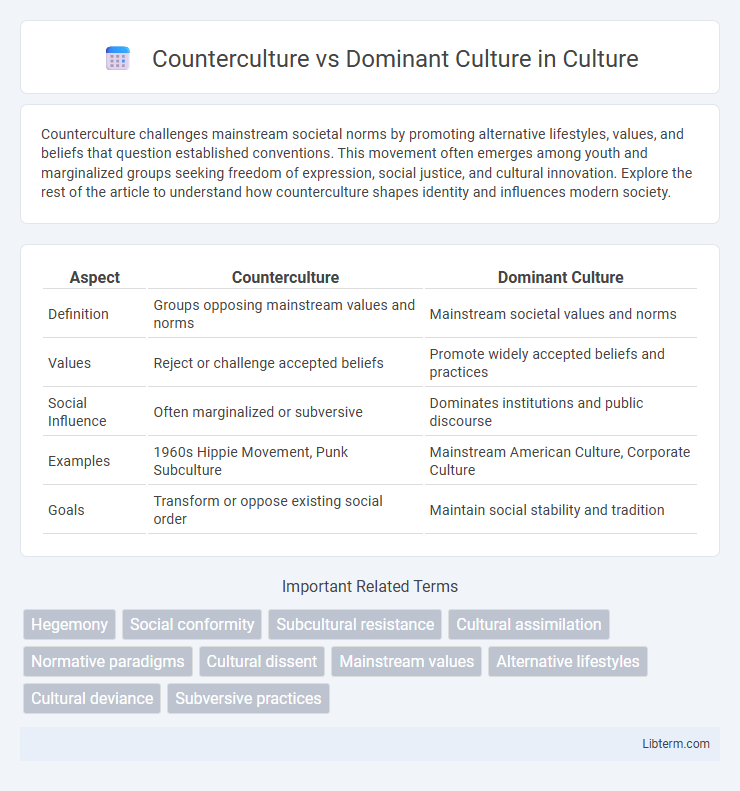Counterculture challenges mainstream societal norms by promoting alternative lifestyles, values, and beliefs that question established conventions. This movement often emerges among youth and marginalized groups seeking freedom of expression, social justice, and cultural innovation. Explore the rest of the article to understand how counterculture shapes identity and influences modern society.
Table of Comparison
| Aspect | Counterculture | Dominant Culture |
|---|---|---|
| Definition | Groups opposing mainstream values and norms | Mainstream societal values and norms |
| Values | Reject or challenge accepted beliefs | Promote widely accepted beliefs and practices |
| Social Influence | Often marginalized or subversive | Dominates institutions and public discourse |
| Examples | 1960s Hippie Movement, Punk Subculture | Mainstream American Culture, Corporate Culture |
| Goals | Transform or oppose existing social order | Maintain social stability and tradition |
Defining Counterculture and Dominant Culture
Counterculture represents a social group whose values, beliefs, and behaviors sharply contrast with those of the dominant culture, often challenging mainstream norms and promoting alternative lifestyles or ideologies. Dominant culture encompasses the prevailing customs, norms, values, and institutions that hold power and influence over societal standards and practices, shaping the collective identity and social order. The dynamic between counterculture and dominant culture highlights tensions in social cohesion, identity formation, and cultural change.
Historical Evolution of Countercultures
Countercultures have historically emerged as reactions to dominant cultural norms, often during periods of social upheaval, such as the 1960s with the rise of the hippie movement opposing mainstream capitalist and conservative values. These movements challenge established institutions through alternative lifestyles, music, fashion, and political activism, influencing broader cultural and social reforms over time. The evolution of countercultures reflects shifting societal priorities, from civil rights and anti-war protests to contemporary movements advocating for environmentalism and digital privacy.
Core Values of Dominant Culture
Dominant culture core values emphasize conformity, individualism, economic success, and social stability, shaping societal norms and institutions. These values prioritize mainstream beliefs such as meritocracy, competition, and traditional family structures, reinforcing the prevailing power dynamics. Understanding these principles clarifies how countercultures emerge in opposition by challenging or redefining such dominant societal ideals.
Key Characteristics of Countercultural Movements
Countercultural movements exhibit key characteristics such as rejection of mainstream societal norms, emphasis on alternative lifestyles, and promotion of radical political or social change. They often advocate for values like communal living, environmental sustainability, and anti-establishment ideologies. These movements challenge dominant culture's authority by creating distinct identities and fostering social innovation.
Influences of Dominant Culture on Society
Dominant culture shapes societal norms, values, and behaviors through institutions like education, media, and government, reinforcing mainstream ideologies and social cohesion. It often marginalizes or assimilates countercultural movements, limiting their influence while maintaining social order. The pervasive impact of dominant culture influences identity formation, consumer habits, and communication patterns within the society.
Major Counterculture Examples in History
Major counterculture movements such as the 1960s Hippie movement in the United States challenged dominant cultural norms by promoting peace, love, and anti-establishment values during the Vietnam War era. The Beat Generation of the 1950s also rejected mainstream American values through experimental literature and nonconformity, influencing later cultural shifts. More recently, the Punk movement emerged in the 1970s, opposing commercialism and societal conformity through music, fashion, and DIY ethics.
Points of Conflict Between Counterculture and Dominant Culture
Counterculture often challenges dominant culture by rejecting its core values, norms, and social institutions, creating conflict over moral beliefs, political ideologies, and lifestyle choices. This clash manifests in social movements, where countercultural groups advocate for civil rights, environmentalism, or alternative lifestyles that oppose mainstream consumerism, authority, and conformity. Conflicts frequently arise in public policy debates, media representation, and generational divides, highlighting resistance against cultural homogenization and institutional control.
Social Impact of Countercultures
Countercultures challenge dominant cultural norms by promoting alternative values, lifestyles, and beliefs that often lead to social transformation. They influence mainstream society by sparking movements for civil rights, environmentalism, and greater social justice, ultimately reshaping policies and public consciousness. The social impact of countercultures includes increased diversity, expanded freedoms, and the questioning of traditional power structures.
Assimilation, Resistance, and Social Change
Counterculture challenges dominant culture by resisting prevailing norms and values, often emphasizing alternative lifestyles and beliefs that promote social change. Assimilation involves the gradual adoption of dominant cultural practices by countercultural groups, which can dilute their original identity but also facilitate broader acceptance and influence. The dynamic tension between these forces drives social transformation, as resistance highlights inequalities while selective assimilation fosters cultural integration and evolution.
The Future Relationship Between Counterculture and Dominant Culture
The future relationship between counterculture and dominant culture will likely involve increased integration and mutual influence as technology accelerates cultural exchange. Countercultures often introduce innovative ideas that gradually permeate and reshape dominant cultural norms, leading to social evolution and greater diversity in values. This dynamic interplay will continue driving shifts in societal attitudes and practices, reflecting ongoing negotiations of identity and power.
Counterculture Infographic

 libterm.com
libterm.com